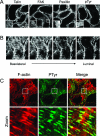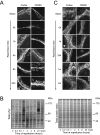Extracellular signal-regulated kinase activation during renal ischemia/reperfusion mediates focal adhesion dissolution and renal injury
- PMID: 17620366
- PMCID: PMC1934533
- DOI: 10.2353/ajpath.2007.060805
Extracellular signal-regulated kinase activation during renal ischemia/reperfusion mediates focal adhesion dissolution and renal injury
Abstract
Acute renal failure due to ischemia/reperfusion involves disruption of integrin-mediated cellular adhesion and activation of the extracellular signal-regulated kinase (ERK) pathway. The dynamics of focal adhesion organization and phosphorylation during ischemia/reperfusion in relation to ERK activation are unknown. In control kidneys, protein tyrosine-rich focal adhesions, containing focal adhesion kinase, paxillin, and talin, were present at the basolateral membrane of tubular cells and colocalized with short F-actin stress fibers. Unilateral renal ischemia/reperfusion caused a reversible protein dephosphorylation and loss of focal adhesions. The focal adhesion protein phosphorylation rebounded in a biphasic manner, in association with increased focal adhesion kinase, Src, and paxillin tyrosine phosphorylation. Preceding phosphorylation of these focal adhesion proteins, reperfusion caused increased phosphorylation of ERK. The specific mitogen-activated protein kinase kinase 1/2 inhibitor U0126 prevented ERK activation and attenuated focal adhesion kinase, paxillin, and Src phosphorylation, focal adhesion restructuring, and ischemia/reperfusion-induced renal injury. We propose a model whereby ERK activation enhanced protein tyrosine phosphorylation during ischemia/reperfusion, thereby driving the dynamic dissolution and restructuring of focal adhesions and F-actin cytoskeleton during reperfusion and renal injury.
Figures





Similar articles
-
Inhibition of extracellular signal-regulated kinases 1/2 provides neuroprotection in spinal cord ischemia/reperfusion injury in rats: relationship with the nuclear factor-kappaB-regulated anti-apoptotic mechanisms.J Neurochem. 2010 Jul;114(1):237-46. doi: 10.1111/j.1471-4159.2010.06747.x. Epub 2010 Apr 9. J Neurochem. 2010. PMID: 20403072
-
Focal adhesion disassembly is regulated by a RIAM to MEK-1 pathway.J Cell Sci. 2012 Nov 15;125(Pt 22):5338-52. doi: 10.1242/jcs.105270. Epub 2012 Sep 3. J Cell Sci. 2012. PMID: 22946047
-
Inhibition of the MEK/ERK pathway reduces microglial activation and interleukin-1-beta expression in spinal cord ischemia/reperfusion injury in rats.J Thorac Cardiovasc Surg. 2007 Apr;133(4):934-41. doi: 10.1016/j.jtcvs.2006.11.038. J Thorac Cardiovasc Surg. 2007. PMID: 17382630
-
FAK/Src family of kinases: protective or aggravating factor for ischemia reperfusion injury in nervous system?Expert Opin Ther Targets. 2015 Apr;19(4):539-49. doi: 10.1517/14728222.2014.990374. Epub 2014 Dec 4. Expert Opin Ther Targets. 2015. PMID: 25474489 Review.
-
The role of focal adhesion complexes in fibroblast mechanotransduction during scar formation.Differentiation. 2013 Oct;86(3):87-91. doi: 10.1016/j.diff.2013.02.003. Epub 2013 Apr 25. Differentiation. 2013. PMID: 23623400 Review.
Cited by
-
Erk in kidney diseases.J Signal Transduct. 2011;2011:768512. doi: 10.1155/2011/768512. Epub 2011 Apr 7. J Signal Transduct. 2011. PMID: 21776388 Free PMC article.
-
ZO-1 protein is required for hydrogen peroxide to increase MDCK cell paracellular permeability in an ERK 1/2-dependent manner.Am J Physiol Cell Physiol. 2018 Sep 1;315(3):C422-C431. doi: 10.1152/ajpcell.00185.2017. Epub 2018 Jun 6. Am J Physiol Cell Physiol. 2018. PMID: 29874107 Free PMC article.
-
Tolerance of the human kidney to isolated controlled ischemia.J Am Soc Nephrol. 2013 Feb;24(3):506-17. doi: 10.1681/ASN.2012080786. Epub 2013 Feb 14. J Am Soc Nephrol. 2013. PMID: 23411786 Free PMC article.
-
Inhibition of ERK1/2 worsens intestinal ischemia/reperfusion injury.PLoS One. 2013 Sep 20;8(9):e76790. doi: 10.1371/journal.pone.0076790. eCollection 2013. PLoS One. 2013. PMID: 24073294 Free PMC article.
-
Limonin, a natural ERK2 agonist, protects against ischemic acute kidney injury.Int J Biol Sci. 2023 May 29;19(9):2860-2878. doi: 10.7150/ijbs.82417. eCollection 2023. Int J Biol Sci. 2023. PMID: 37324945 Free PMC article.
References
-
- Molina A, Ubeda M, Escribese MM, Garcia-Bermejo L, Sancho D, de Lema GP, Liano F, Cabanas C, Sanchez-Madrid F, Mampaso F. Renal ischemia/reperfusion injury: functional tissue preservation by anti-activated β1 integrin therapy. J Am Soc Nephrol. 2005;16:374–382. - PubMed
-
- Zalewska T, Makarewicz D, Janik B, Ziemka-Nalecz M. Neonatal cerebral hypoxia-ischemia: involvement of FAK-dependent pathway. Int J Dev Neurosci. 2005;23:657–662. - PubMed
-
- Zalewska T, Ziemka-Nalecz M, Domanska-Janik K. Transient forebrain ischemia effects interaction of Src FAK, and PYK2 with the NR2B subunit of N-methyl-D-aspartate receptor in gerbil hippocampus. Brain Res. 2005;1042:214–223. - PubMed
-
- Zuk A, Bonventre JV, Brown D, Matlin KS. Polarity, integrin, and extracellular matrix dynamics in the postischemic rat kidney. Am J Physiol. 1998;275:C711–C731. - PubMed
-
- Raman N, Atkinson SJ. Rho controls actin cytoskeletal assembly in renal epithelial cells during ATP depletion and recovery. Am J Physiol. 1999;276:C1312–C1324. - PubMed
Publication types
MeSH terms
Substances
LinkOut - more resources
Full Text Sources
Molecular Biology Databases
Miscellaneous

